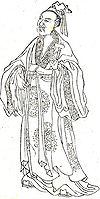Difference between revisions of "Wang Xizhi" - New World Encyclopedia
Keisuke Noda (talk | contribs) (import from wiki) |
Keisuke Noda (talk | contribs) |
||
| Line 29: | Line 29: | ||
[[Image:Wang Xizhi by Qian Xuan.jpg|thumb|200px|Painting by Wang Xizhi]] | [[Image:Wang Xizhi by Qian Xuan.jpg|thumb|200px|Painting by Wang Xizhi]] | ||
| + | ==Lantingji Xu== | ||
| + | The '''''Lantingji Xu''''' ({{zh-tspwl|t=蘭亭集序|s=兰亭集序|p=Lántíngjí Xù|w='''Lant'ingchi Hsü'''|l=Preface to the Poems Composed at the Orchid Pavilion}}) or '''''Lanting Xu''''' (蘭亭序) is the most famous work of [[Chinese calligraphy|calligraphy]] by [[Wang Xizhi]], composed in year [[353]]. Written in [[semi-cursive script]], it is the most well-known and well-copied piece ever. It describes a gathering of 42 literati including [[Xie An]] and Sun Chuo (孙绰) at the Orchid Pavilion near [[Shaoxing|Shaoxing, Zhejiang]], during the Spring Purification Festival to compose poems and enjoy the wine. | ||
| + | |||
| + | It consists of 324 [[Chinese characters]] in 28 lines. The character ''zhi'' (之) appears 17 times, but no two look the same. It is also a celebrated work of [[Chinese literature|literature]], flowing rhythmically and giving rise to several [[Chinese idiom]]s. It is a piece of improvisation, as can be seen from the revisions in the text. | ||
| + | |||
| + | [[Emperor Taizong of Tang]] liked Wang's calligraphy so much that he ordered a search for the original copy of ''Lanting Xu''. It is believed that the Emperor took the original in his tomb after his death. Numerous tracing copies and other forms of duplications such as rubbings exist today. | ||
| + | |||
| + | [[Image:LantingXu.jpg|850px]] | ||
== References == | == References == | ||
| − | {{ | + | {{Chinesetext}} |
| + | {{wikisource|Preface to the Poems Composed at the Orchid Pavilion}} | ||
| + | * Li, Siyong, [http://www.wordpedia.com/search/Content.asp?ID=64934 "Wang Xizhi"]. ''[[Encyclopedia of China]]'' (Chinese Literature Edition), 1st ed. | ||
* Li, Siyong, [http://www.wordpedia.com/search/Content.asp?ID=64934 "Wang Xizhi"]. ''[[Encyclopedia of China]]'' (Chinese Literature Edition), 1st ed. | * Li, Siyong, [http://www.wordpedia.com/search/Content.asp?ID=64934 "Wang Xizhi"]. ''[[Encyclopedia of China]]'' (Chinese Literature Edition), 1st ed. | ||
| Line 44: | Line 54: | ||
[[Category:Chinese people in history]] | [[Category:Chinese people in history]] | ||
| − | + | ((credits|Wang_Xizhi|144629213|Lantingji_Xu|144631995}} | |
| − | ((credits|Wang_Xizhi|144629213}} | ||
Revision as of 20:35, 26 July 2007
| Names | |
|---|---|

| |
| Chinese: | 王羲之 |
| Pinyin: | Wáng Xīzhī |
| Wade-Giles: | Wang Hsi-chih |
| Zi: | Yìshào (逸少) |
| Hao: | Dànzhāi (澹斋) |
| Also known as: | Shūshèng (書聖, literally Sage of Calligraphy) |
- This is a Chinese name; the family name is 王 (Wang).
Wang Xizhi (Chinese: 王羲之, 303–361) was a Chinese calligrapher, traditionally referred to as the Sage of Calligraphy (書聖).
Born in Linyi, Shandong, he spent most of his life in the present-day Shaoxing, Zhejiang. He learned the art of calligraphy from Wei Shuo. He excelled in every script but particularly in the semi-cursive script. Unfortunately, none of his original works remains today.
His most famous work is the Preface to the Poems Composed at the Orchid Pavilion, the preface of a collection of poems written by a number of poets when gathering at Lanting near the town of Shaoxing for the Spring Purification Festival. The original is lost, but there are a number of fine tracing copies and rubbings. Wikisource has the text with translation.
Wang Xizhi is particularly remembered for one of his hobbies - rearing geese. Legend has it that he learnt the key of how to turn his wrist while writing by observing how the geese move their necks.
Wang Xizhi had seven children, all of whom were notable calligraphers. The most distinguished one was his youngest son, Wang Xianzhi.
Lantingji Xu
The Lantingji Xu (Traditional Chinese: 蘭亭集序; Simplified Chinese: 兰亭集序; pinyin: Lántíngjí Xù; Wade-Giles: Lant'ingchi Hsü; literally "Preface to the Poems Composed at the Orchid Pavilion") or Lanting Xu (蘭亭序) is the most famous work of calligraphy by Wang Xizhi, composed in year 353. Written in semi-cursive script, it is the most well-known and well-copied piece ever. It describes a gathering of 42 literati including Xie An and Sun Chuo (孙绰) at the Orchid Pavilion near Shaoxing, Zhejiang, during the Spring Purification Festival to compose poems and enjoy the wine.
It consists of 324 Chinese characters in 28 lines. The character zhi (之) appears 17 times, but no two look the same. It is also a celebrated work of literature, flowing rhythmically and giving rise to several Chinese idioms. It is a piece of improvisation, as can be seen from the revisions in the text.
Emperor Taizong of Tang liked Wang's calligraphy so much that he ordered a search for the original copy of Lanting Xu. It is believed that the Emperor took the original in his tomb after his death. Numerous tracing copies and other forms of duplications such as rubbings exist today.
ReferencesISBN links support NWE through referral fees
| This article contains Chinese text. Without proper rendering support, you may see question marks, boxes, or other symbols instead of Chinese characters. |
- Li, Siyong, "Wang Xizhi". Encyclopedia of China (Chinese Literature Edition), 1st ed.
- Li, Siyong, "Wang Xizhi". Encyclopedia of China (Chinese Literature Edition), 1st ed.
External links
((credits|Wang_Xizhi|144629213|Lantingji_Xu|144631995}}


